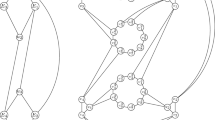Abstract
This paper introduces a fractional version of the classical maximum weight clique problem, the maximum ratio clique problem, which is to find a maximal clique that has the largest ratio of benefit and cost weights associated with the clique’s vertices. NP-completeness of the decision version of the problem is established, and three solution methods are proposed. The results of numerical experiments with standard graph instances, as well as with real-life instances arising in finance and energy systems, are reported.
Similar content being viewed by others
References
Billionnet A (2002) Approximation algorithms for fractional knapsack problems. Oper Res Lett 30(5): 336–342
Boginski V, Butenko S, Pardalos P (2006) Mining market data: a network approach. Comput Oper Res 33:3171–3184
Bomze IM, Budinich M, Pardalos PM, Pelillo M (1999) The maximum clique problem. In: Du DZ, Pardalos PM (eds) Handbook of combinatorial optimization. Kluwer Academic Publishers, Dordrecht, pp 1–74
Chandrasekaran R (1977) Minimal ratio spanning trees. Networks 7(4):335–342
Chvátal V, Slater P (1993) A note on well-covered graphs. Ann Discrete Math 55:179–182
Dantzig GB, Blattner WO, Rao MR (1967) Finding a cycle in a graph with minimum cost to time ratio with application to a ship routing problem. In: Rosentlehl P (ed) Theory of graphs. Gordon and Breach, New York, pp 77–84
Dasdan A, Gupta R (1998) Faster maximum and minimum mean cycle algorithms for system-performance analysis. IEEE Trans Comput Aided Des Integr Circ Syst 17(10):889–899
Dinkelbach W (1967) On nonlinear fractional programming. Manag Sci 13(7):492–498
Elhedhli S (2005) Exact solution of a class of nonlinear knapsack problems. Oper Res Lett 33:615–624
Fox B (1969) Finding minimal cost-time ratio circuits. Oper Res 17(3):546–551
Garey MR, Johnson DS (1979) Computers and Intractability: a Guide to the theory of NP-completeness. W.H. Freeman and Company, New York
Ibaraki T (1983) Parametric approaches to fractional programs. Math Program 26:345–362
Isbell JR, Marlow WH (1956) Attrition games. Naval Res Logist Q 3(1–2):71–94
Karp RM (1978) A characterization of the minimum cycle mean in a digraph. Discrete Math 23(3):309–311
Lawler EL (1976) Combinatorial optimization: networks and matroids. Holt, Rinehart and Winston, New York
Luce R, Perry A (1949) A method of matrix analysis of group structure. Psychometrika 14:95–116
Megiddo N (1979) Combinatorial optimization with rational objective functions. Math Oper Res 4(4):414–424
NREL: transmission grid integration - data and resources (2012). http://www.nrel.gov/electricity/transmission/data_resources.html. Accessed October 2013
Orlin JB, Ahuja RK (1992) New scaling algorithms for the assignment and minimum mean cycle problems. Math Program 54:41–56
Picard JC, Queyranne M (1982) A network flow solution to some nonlinear 0–1 programming problems, with applications to graph theory. Networks 12:141–159
Prokopyev O, Meneses C, Oliveira C, Pardalos P (2005) On multiple-ratio hyperbolic 0–1 programming problems. Pac J Optim 1(2):327–345
Prokopyev OA, Huang H, Pardalos PM (2005) On complexity of unconstrained hyperbolic 0–1 programming problems. Oper Res Lett 33(3):312–318
Radzik T (1998) Fractional combinatorial optimization. In: Du DZ, Pardalos P (eds) Handbook of combinatorial optimization, vol 1. Kluwer Academic Publishers, pp 429–478
Radzik T (1992) Newton’s method for fractional combinatorial optimization. In: Proceedings of 33rd annual symposium on foundations of computer science, pp 659–669
Sankaranarayana R, Stewart L (1992) Complexity results for well-covered graphs. Networks 22:247–262
Shigeno M, Saruwatari Y, Matsui T (1995) An algorithm for fractional assignment problems. Discrete Appl Math 56:333–343
Skiscim C, Palocsay S (2004) The complexity of minimum ratio spanning tree problems. J Glob Optim 30:335–346
Tawarmalani M, Ahmed S, Sahinidis NV (2002) Global optimization of 0–1 hyperbolic programs. J Glob Optim 24:385–416
Ursulenko O, Butenko S, Prokopyev O (2013) A global optimization algorithm for solving the minimum multiple ratio spanning tree problem. J Glob Optim 56:1029–1043
Wiser R, Lantz E, Bolinger M, Hand M (2012) Recent developments in the levelized cost of energy from us wind power projects. http://eetd.lbl.gov/ea/emp/reports/wind-energy-costs-2-2012.pdf. Accessed October 2013
Wu T (1997) A note on a global approach for general 0–1 fractional programming. Eur J Oper Res 101(1):220–223
Acknowledgments
This research was partially supported by the US Department of Energy Grant DE-SC0002051 and US Air Force Office of Scientific Research Award No. FA9550-12-1-0103. The authors gratefully acknowledge the comments by two referees.
Author information
Authors and Affiliations
Corresponding author
Rights and permissions
About this article
Cite this article
Sethuraman, S., Butenko, S. The maximum ratio clique problem. Comput Manag Sci 12, 197–218 (2015). https://doi.org/10.1007/s10287-013-0197-z
Received:
Accepted:
Published:
Issue Date:
DOI: https://doi.org/10.1007/s10287-013-0197-z




